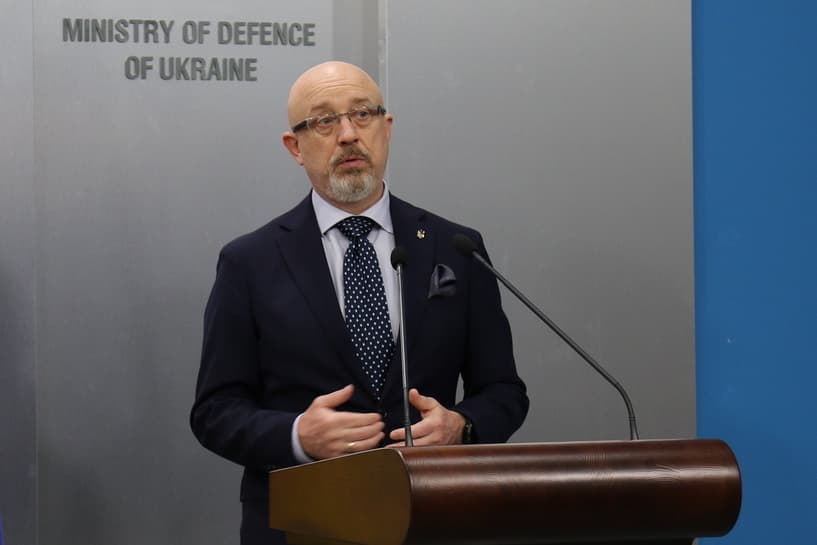Defense minister downplays Russian threat, says it's similar to that of spring 2021

The current Russian military buildup near Ukrainian borders is not much different from the situation in spring 2021, Ukraine’s Defense Minister Oleksii Reznikov said on Jan. 28.
Reznikov explained that Russia currently has about 130,000 troops arrayed around Ukraine, which he says is not significantly different from the March-April period when Moscow deployed roughly 126,000 soldiers to areas close to the border.
“The number (of Russian troops) then and now are similar, but the (Western) reactions are disproportionate,” he said while speaking to the parliament.
While acknowledging that Russia has increased its military buildup from a size of 110,000 in December, Reznikov said the Kremlin hasn’t launched any military events or actions that make the current situation more dangerous.
The statement contradicts the recent Western reports that continue to raise the alarm about the mounting tensions on the Ukrainian border.
For weeks, the eyes of the world have been on the Russia-Ukraine standoff as Western leaders struggle to decipher Russian President Vladimir Putin’s intent. Russia says that it has no plans to stage an attack, but the massive buildup of its troops near Ukraine continues to spur fears that Moscow is about to invade Ukraine further.
Russia may have bolstered its military presence on Ukraine’s border by sending 300 more tanks than in spring, but the Ukrainian army is already well equipped with modern weapons including powerful Javelin anti-tank missiles, Reznikov said.
Amid soaring tensions, Western countries have stepped up arms deliveries to Ukraine to help the country defend its borders. The defense minister said he couldn’t announce the amount of military aid, but it was “more optimistic than what was reported in the media.”
According to Reznikov, the only difference between the current troop buildup and what happened last spring was the Russian-Belarusian military drills scheduled for February. Russia has already begun sending military troops and combat vehicles to the western rim of Belarus, where the exercise will take place. The location is close to Ukrainian borders as well as NATO’s eastern members Poland and Lithuania.
Ukrainian officials expect Russian troops deployed to Belarus for the exercises to remain in place indefinitely, which would leave Ukraine open to attack from the north, the east and the south. The exercise could effectively put pressure on Ukraine’s defense by way of the two country’s 1,130-kilometer border with Ukraine, experts say.
While Russia continues to increase pressure on Ukraine by deploying larger forces in Belarus, Reznikov said this poses a greater threat to Minsk than to Kyiv.
“We are watching the northern direction closely,” he said. “To date, there were no attempts to attack Ukraine.”
The Russian soldiers sent for the drills look more like continents occupying Belarus rather than a strike group, Reznikov said.
While concerns mount over the possibility of an all-out war, Ukrainian state officials continue to downplay the near-term threat of Russian invasion.
U.S. President Joe Biden reportedly warned his Ukrainian counterpart Volodymyr Zelensky that a Russian attack is now virtually certain as soon as the ground would freeze later in February. The two leaders reportedly disagreed on the “risk levels” of a Russian attack during a phone call on Jan. 27. Zelensky's administration denied this.
Military analysts observing Russia's moves said much of the buildup so far have involved troops and equipment including tanks and heavy armor so far, some of which have traveled by train from bases in the far east of the country.
Experts say that if Russia is planning to launch another invasion of Ukraine, the Kremlin would need to deploy reserve soldiers and logical infrastructure like field hospitals, which appeared to be missing until recently, The New York Times reported.
However, the Wall Street Journal reported on Jan. 27 that Moscow sent medical units towards the Ukrainian border. "Moscow has put what appear to be final preparations for an invasion of Ukraine by sending medical units to the front, moving to a level of readiness that it hadn’t reached in past buildups," the media wrote, citing Western defense officials.
Reznikov said in his speech that he expected the threats to increase by the end of January, but “our task is to focus on preparing a joint response to these challenges with international partners.”










